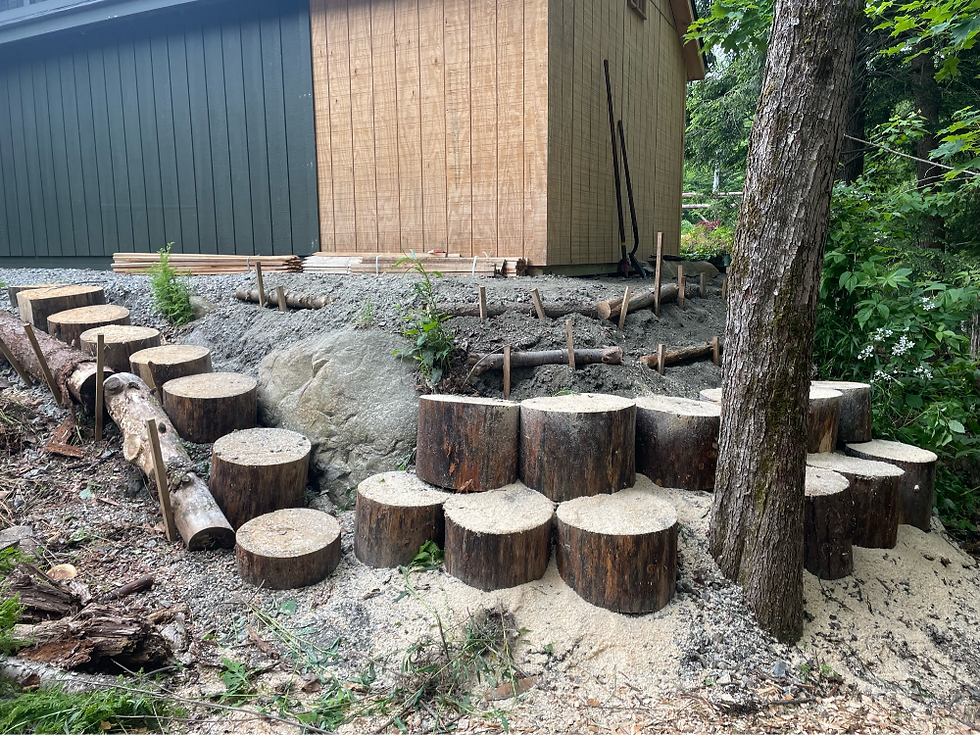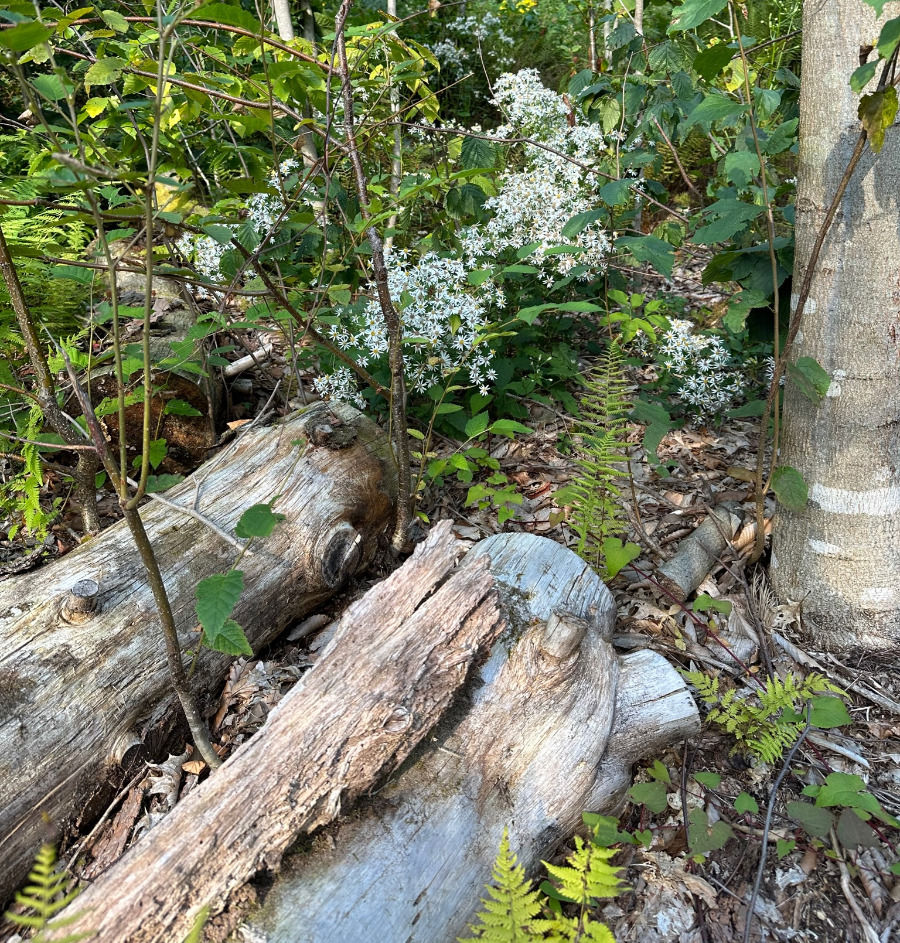Berkshire Garden Style: Fun Things to Do with Dead Stuff (from the garden, that is!)
Jenna O'brien author | Amanda Giracca editor |

Standing deadwood as the backdrop for late-season Rudbeckia and New England Aster.
In my last blog post, I shared the story of finding a pile of Canadian Thistle on my property. As I said, I’d left the pile to sit in a wheelbarrow, bungeed beneath a tarp, in my shed. Well, here’s what happened: it sat in that wheelbarrow in that hot shed under that tarp until it became a wet, stinking, sloppy mess, like a very stinky soup stock. None of the buds ever opened. Feeling confident that the plant matter was sufficiently putrefied, I dumped the liquidy mess onto my compost. I continue to monitor the area. I believe the perpetrator attempted to dump again, but we were home that day and the dogs began barking. Whoever was stopped there – it was the same exact spot – jumped in their red pickup truck and drove away.
As promised, I want to spend this blog post talking about fun, creative ways to utilize garden clippings – what I might call garden “waste.” How might we not waste this material? I want to consider the ways we might use this material to support the environment and the ways we might use it to create something in the likes of Andy Goldsworthy’s art: beautiful, yet impermanent. Some of these ideas are fun and creative, but also built into all of them are aspects of utility, sustainability, and a challenge to reconsider the impulse to remove dead material from a landscape and to dispose of it. If my last blog post was a plea to homeowners to reconsider where and how they dispose of garden waste, consider this a plea to shift our conventional views of beauty.

We wouldn’t have this lush arrangement of vegetation without
the decomposing log retaining all that water.

Andy Goldsworthy doesn’t add or take from the landscape – he rearranges in order to shift our perspective, make us see what we couldn’t see before.
Photo courtesy of Crichton University, Woven branch circular arch, Langholm, Dumfriesshire , April 1986
© Andy Goldsworthy

The obvious use: firewood. (And isn’t this stack beautiful?)
Using:
In Viridissima’s practice, as our last post discussed, we make various piles, on site, for different kinds of vegetation: green material with high water content that breaks down rapidly, woody material, a stone pile. As much as we can, we keep this stuff on the property and use it for mulch, compost, and other projects. It’s fall, and tree leaves are, to me, one of the most valuable bits of waste we can use in the garden. Maple leaves, especially Sugar Maple leaves, make for the best leaf mould, and leaf mould is what feeds our forests.
Wood chips, while a convenient way to process tree material, are also incredibly useful. I use processed Spruce tops and tips as mulch, and hardwood chips make great path mulch, as was recently done by the artist-in-residence at Berkshire Botanical Garden when she asked my advice on how she might use the chipped branches of a Black Locust that had to be taken down.
When we’re working in the garden and we need to stake something, we don’t wait until someone’s made a trip to the store for Bamboo stakes (especially not those dyed-green ones that, although green, stand out like a sore thumb in the garden), we harvest something straight from the brush pile or even cut a sapling if it’s okay to take one.

Making use of a recent tree harvest to create a log retainer wall.

It’s a brush pile. It’s a hedge. It’s both!
Making something beautiful:
In many ways, utility = beauty to me, so maybe this is a funny distinction to make. But some projects I’ve come across have been particularly aesthetic, and I want to highlight a few I’ve come across (and a few of my own).
I’ve created dead hedges at clients’ properties as well as my own, using branches and even brushier material to create a fence along the road line. The fence has a purpose, yet it’s striking. We see not just a pile, but a structure. The resourceful neighbors of BBG also created a dead hedge when they wished to create delineation between their private space and BBG’s not-private space.
I’ve seen people make use of cut saplings by making a serpentine fence winding through a forest understory, which "tidied up" the public woodland while not denuding the forest ecosystem of its resources. It’s a little more labor intensive than simply piling the saplings, but the result was striking – beautiful and useful.

One of my indulgences is watching interior design and decorating programs. In a recent episode, I noted a spray of Crocosmia seed heads in a fancy vase. Naturally, I skipped out to our nursery, cut the few that we had, and continue to enjoy them adorning our shed door.
I’m always collecting seed pods, seed heads, vines, and fallen leaves that have good structure and hold up well. These are beautiful on their own, and also make wonderful decorations. Go to Campo de Fiori in Sheffield to shop for sumptuously organic Christmas decor, and you can peruse Barbara’s foraged garden treasures – Allium heads and Milkweed pods, for example – that she’s dried and painted gold.

These scapes from Heucera x ‘Mega Caramel’ weren’t visually working
for me on the plants in their decorative planters, but they brought
my client and me pleasure for a few days right here.

The glowing moon seedheads of Lunaria annua are left standing to bring
a new dimension to the garden long after their June flowers have faded.
I recently learned about a florist who, instead of using the foam florist blocks, which have been shown to contain toxic components like phenol and formaldehyde, uses a tangle of pliable twigs stuffed deep into the vase to hold her flower arrangements together.

Leaving for others to use (with a little bit of rearranging):
When my crew is working in a woodland, cutting saplings, say, or tidying up if it’s an important sight line, we will create tipis out of the saplings and leave them standing in the woods (see above photo). We’re not removing anything, just rearranging. These little stick huts become habitat for woodland creatures, especially if constructed around stumps and regularly spaced apart. (Here’s an interesting take tipi building from Washington State’s Department of Natural Resources commissioner, Hilary Franz.)
One of the most compelling and beautiful uses of wood scraps I’ve seen is the construction of Mason Bee habitat. Mason Bees use natural cavities, small holes in wood which they plug with mud to make a nest. Here are some exquisitely artistic examples that people have made:

Insect hotel in public park
Photo: Marc Bode/ Shutterstock.com

Bees Hotel. Image courtesy of Ong-Mat/flickr
I don’t think everyone is going to take the time to make a Mason Bee hotel out of scrap wood, but I think the construction and display of these sculpture-habitats make an educational point. It’s an ornamental way to say, hey, these creatures are living in your garden waste. Like the work of Andy Goldsworthy, it’s an extreme, eye-catching way to build awareness.
Leaving and letting it be beautiful as it is:
A lot of what I feature isn’t even manipulated; it’s just left there in the landscape. And it’s beautiful. As you’ve read in previous blog posts, challenging the way we think about what is beautiful is important to me. For example, why is this use of dead wood considered beautiful:

But this isn’t?

To me, both are beautiful. One is useful to us and the other is useful to other creatures, the forest, the soil, the Earth.
Earlier this year I talked about the importance of standing deadwood and how I had left some limbed trees on my own property. Well, a similar project has taken off at a client’s house. It’s a standing deadwood garden we’ve dubbed the Impossible Forest. This month, we will be topping and limbing some Spruces and we will leave them as standing deadwood poles, between 12 and 28 feet tall. These poles will be the foundation for the Impossible Forest. At the base of each, we will plant Climbing Hydrangeas and/or Virginia Creeper. Near to, but not among the columns, will be a pair of Weeping Katsura trees. Together, this arrangement makes a chicanery, as my friend and garden designer Anthony Archer-Wills calls it: an opening that fools the eye. From afar, the garden/forest/planting looks as though it’s an impenetrable wall, but the plantings have been overlapped in a way so you can see the gaps between them. The combination of new trees and standing deadwood adds layers of complexity and richness.

The beginning phases of the Impossible Forest. All the Spruces in the foreground are declining due to a widespread fungal issue that we have been unable to resolve. Their stems will stay. All branches and tops will go.

A different view of the Spruces.

My standing Spruce columns. The initial experiment before committing
to the Impossible Forest project.
I don’t mean to suggest any gardener must use standing deadwood or create a masterpiece out of scrap wood for Mason Bee nests. What’s most important is good management: keeping piles of woody, compostable, leaf mould, stone, etc. and appropriately situating them on a property, or properly removing it to a place off site. The key point is that it’s being used for something else and by leaving it we embrace ALL aspects of the garden that make the garden: the gardener, the scraps, the creatures. It's about not casting off what one may deem no-good. It's about not taking the best cut off the wedge of cheese and tossing the rest. What’s dead is not useless – it will be used by someone for something. And sometimes, I think it’s important to highlight that in my work. To frame it, showcase it as part of the landscape, not something simply beyond the garden. I think we and very many other creatures benefit when we begin to reconsider what we call beautiful.

(1)_edited_.jpg)








Comments